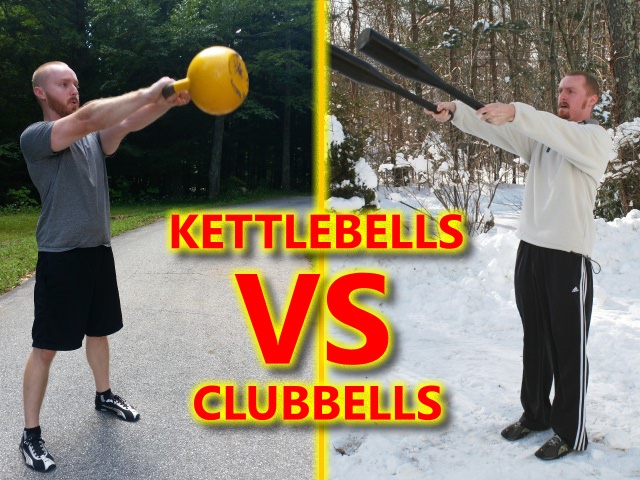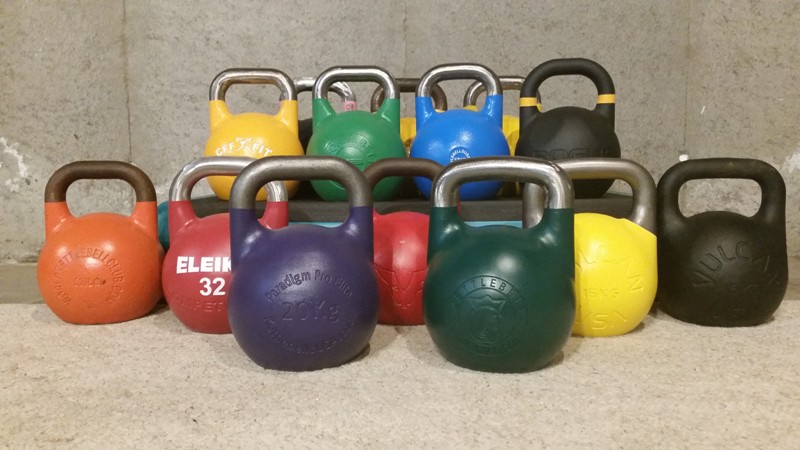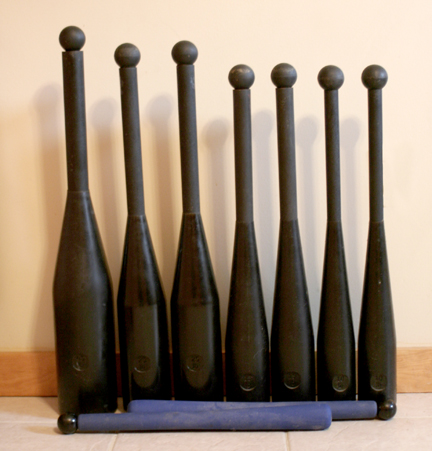How Clubbells and Kettlebells Compare, Contrast, and Complement Each Other – The Pros and Cons of Each, Key Differences, and the Best Exercises for Each Tool

What are the key differences between kettlebells and clubbells (or other weighted clubs), and which tool is more suitable for you? Let’s find out.
Clubbells and kettlebells are both great training tools that I’ve enjoyed using for many years. And while there are many similarities between them, especially in their application, there are also some distinct differences. Clubbells and kettlebells are both portable, compact free weights that can be lifted and swung in many dynamic movements for a variety of fitness purposes, such as:
- body composition goals like fat loss and muscle building
- strength & conditioning for both general and specific physical preparation (i.e. GPP & SPP)
- athletic and vocational performance enhancement
- injury prevention
- and many others!
Now, both of these tools are unique from more traditional strength training equipment because they involve leverage, momentum, torque, and traction (note: clubbells involve all of these qualities to a greater degree than kettlebells). These unique qualities enable these tools to be more easily and effectively used for training in and through dynamic, circular, multi-planar movement patterns than more conventional strength training equipment. It also means that you can use a much lighter clubbell or kettlebell to produce the same conditioning effects as a heavier dumbbell or barbell, for instance, which often results in less wear and tear on your body.
Clubbells and kettlebells are both fun, versatile, safe, and effective tools for improving your health, fitness, strength and conditioning. So, in the grand scheme of things, they’re very similar tools, and we’re kindof comparing apples to apples. And when it comes to choosing which one is right for you, it usually comes down to your personal preferences.
Now, I’ve been training with clubbells for the last ten years, and kettlebells a bit longer than that. And I guess that when you’ve spent that much time working with a tool, you’re able to talk about it for a very long time. Hence, the following 28 minute verbal dissertation on the similarities and differences between clubbells and kettlebells, in which I only rambled for about 30 seconds, and I still didn’t cover everything I should have!
So, if you’d like to know the pros and cons of each tool, and specifically, how they compare, contrast, and complement one another, check out the video below…or scroll down for the text summary if you can’t stand to stare at my ugly mug for 28 minutes straight.
CLUBBELLS VS KETTLEBELLS – VIDEO COMPARISON
Note: after editing the video above, I realized that I did a lot more talking than showing. So, I’ve included a couple of training videos below to help you better visualize how these tools can be used.
Kettlebells VS Clubbells: Advantages & Disadvantages
The following list of pros and cons deals specifically with clubbells and kettlebells as compared to one another, and not necessarily compared to all other strength training tools, which would require much longer lists!
Clubbell PROS
- More of an innovative fitness tool that fills gaps in strength & conditioning that other tools can’t.
- Superior tool for almost all swinging exercises.
- Greater variety of unique movements patterns, and more sophisticated exercises that you can train with.
- More versatile in that you can do more with a single clubbell than a single kettlebell.
- Greater leverage disadvantage, making the tool LESS efficient, meaning you have to be MORE efficient.
- Greater traction effect, which will help heal, restore, and strengthen your joints.
- Significantly lighter weights can be used to elicit comparable conditioning effects with less wear and tear on your body.
- Less compression on your joints and skeletal system.
- Superior for training grip strength and learning the use of “intelligent grip”. Also, there are numerous ways to grip the clubs (1-handed, 2-handed, hands close together, hands further apart, barrel up, barrel down, close to center of mass, further from center of mass, etc.), creating many unique training possibilities.
- Superior tool for mobilizing & strengthening the shoulders in all degrees of freedom.
- Can be used to strengthen deeper and/or more extreme ranges of motion.
- Covered in rubber (i.e. safer in case of impact with body).
- With the clubbell handle, you can micro-adjust your grip to change the leverage disadvantage and make exercises harder or easier.
- Better for strengthening virtually all lateral, rotational, and circular movements – like those used in sports and many day to day activities.
- Superior tool for all-around core strength and development, and full-body training, in general.
- More versatile for sport-specific, vocation-specific, and hobby-supportive training.
Clubbell CONS
- Longer & steeper learning curve than most strength and conditioning tools. Professional instruction is highly recommended, and necessary, in most cases.
- Inferior tool for most traditional S&C exercises (e.g. overhead presses).
- Grip strength is often a limiting factor (especially for beginner trainees), meaning that your grip will often fatigue before anything else until initial training adaptations have occurred.
- Can be too long for certain exercises when used by shorter trainees.
- Not a well-known training tool, and thus, there’s a much smaller club swinging community & fewer coaches, programs, and classes, etc.
Kettlebell PROS
- More of a balanced training tool, in that, it can be more effectively used for a greater variety of goals.
- Superior tool for most lifting exercises.
- Shorter learning curve.
- Makes more sense to the conventional fitness crowd, and thus, they’re easier to learn for most people (i.e. more suitable for your average fitness trainee).
- Superior tool for most overhead movements (e.g. presses, TGU’s, etc.).
- Superior tool for most hinging movements (e.g. swings, cleans, snatches).
- Can be effectively substituted for almost all other traditional weightlifting exercises (e.g. any dumbbell or barbell exercise).
- More popular and mainstream, which means a bigger community & more good coaches, programs and classes available – online and offline.
- You can compete in kettlebell sport since competitions are held all around the world.
Kettlebell CONS
- You’ll need more of them to really take advantage of their potential (e.g. you’ll need really heavy ones for strength work & light ones for endurance work). This is also true of clubbells, but to a lesser degree.
- You tend to outgrow them faster than clubbells (i.e. you can use a light clubbell for much longer than a light kettlebell).
- Inferior for most swinging exercises, especially lateral, rotational, and multi-directional exercises.
- Can be too bulky for certain exercises.
Note: I’m sure that I’ve neglected to mention many other things that could go on these lists!
The Best Clubbell Exercises
Some of the best clubbell exercises include:
- All swipes variations (e.g. front swipe, side swipe, 1-handed, or 2-handed)
- Mills (and all variations)
- Hammer Swings (and its building blocks, e.g. side rock-its, side swings, side semis, etc.)
- Gama Casts (and all other casts)
- All leverage presses and holds (e.g. flag press, leverage press, etc.)
- Arm Circles (i.e. inside/outside/front/back circles in both directions)
- Clockwork Squats & Barbarian Squats
- All lateral swings (e.g. side rock-its, side swings, side pendulums, side swipes, etc.).
Here is a video that demonstrates many different clubbell exercises to give you a better idea of what kinds of things you can use this tool for.
Clubbell Freestyle Practice Session
The Best Kettlebell Exercises
Some of the the best kettlebell exercises include:
- All Front Swing Variations (2-handed, 1-handed, soft-style or hard-style),
- Cleans
- Snatches
- the Long Cycle Clean and Jerk
- All Overhead Presses (i.e. presses, push presses, and push jerks, etc.),
- The Turkish Get-Up
- Goblet Squats
Here is a video that demonstrates many different kettlebell exercises to give you a better idea of what kinds of things you can use this tool for.
Kettlebell Freestyle Practice Session
The Bottom Line
The bottom line is that these are both superb training tools, and you can’t go wrong with either one of them. So, for most people, it really comes down to your personal preferences. And besides, the tool doesn’t matter nearly as much as HOW you use them. So, whichever tool you think that you’d enjoy using more, and thus, would be more inclined to stick with over the long term – THAT is the one I think you should invest in.
Of course, the best option is to get and use both. And if you do, I’d recommend starting with kettlebells since they’re easier to learn and will shorten the learning curve once you start working with clubs.
Which kettlebells do I recommend?
Good question! My top two choices are the competition kettlebells from Kettlebells USA and Kettlebell Kings. Both companies offer excellent choices at great prices. But there are a lot of other good options out there, too. So, feel free to check out my new complete kettlebell review, where I showcase some of the best kettlebells from all of the top brands: 14 Kettlebells Compared: The Complete Kettlebell Review.
Note: you can also download my Kettlebell Buyer’s Guide here.
Which clubbells do I recommend?
The original CST clubbells are by-far my top choice, and you can click here to learn why: The Complete Clubbell Review.
Note: I also posted a follow-up review of the clubbell here: Clubbells (10 Years Later).
If you found this article helpful, please share it with your friends:
.jpg)
![]()
Health-First Fitness Coach
P.S. If you liked this post, then please signup for the newsletter, or follow me on Facebook or Twitter for daily updates and other interesting info.
More Information
KETTLEBELLS
- 14 Kettlebells Compared: The Complete Kettlebell Review
- The Top 3 Kettlebells (Video Review)
- Don’t Buy Russian Kettlebells Until You’ve Seen This
- The Definitive Guide for Buying Kettlebells
- Kettlebell Archives
CLUBBELLS
- The Complete Clubbell Review
- Clubbell Workouts – One, Two, Three.
- Clubbell Training Programs – Clubbell Flow Evolution (top choice!), Clubbell Hero Evolution, Clubbell Mass Evolution
- Clubbell Training Interviews – One, Two, Three.
- Clubbell Videos
- Clubbell Archives


Nice post John. I like how you have summed up both pros and cons of both. I look forward to reading more!
All the best,
Harry Simonis
Thanks, Harry!
Dear Mr. Sifferman,
I thought I would be able to handle a 20 lb clubbell, but its too heavy for me. I can only workout for about 10 minutes with the 20 lb clubbell because it wears me out. Should I keep working out with the 20 lb clubbell or purchase a new 15 lb clubbell.
Vince